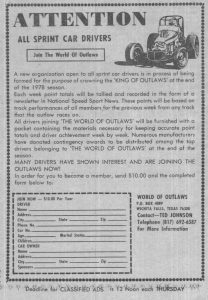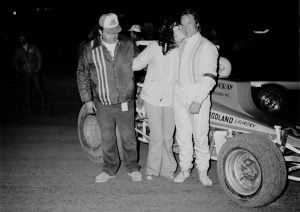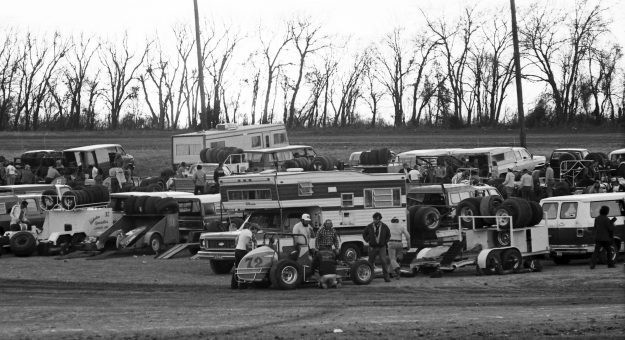Forty-five years ago — on Saturday night, March 18, 1978 — an upstart organization that would eventually reshape the motorsports landscape had a rather inauspicious beginning.
During the mid-1970s, the popularity of “outlaw” sprint car racing was growing across the country as drivers such as Jan Opperman, Rick Ferkel and Bobby Allen barnstormed the nation’s dirt tracks in search of the sport’s richest rewards.
When each season drew to a close, race fans — and competitors — often disagreed as to which outlaw racer had enjoyed the most successful season.
Ted Johnson, a salesman and occasional racing promoter from Wichita Falls, Texas, had a plan to settle the debate, and he shared his concept through an advertisement in the March 8, 1978, issue of National Speed Sport News.

THE OUTLAWS AD: “A new organization open to all sprint car drivers is in process of being formed for the purpose of crowning the ‘KING OF OUTLAWS’ at the end of the — 1978 season. Each week point totals will be tallied and recorded in the form of a newsletter in National Speed Sport News. These points will be based on track performances of all members for the previous week from any track that the outlaw races on.
“All drivers joining ‘THE WORLD OF OUTLAWS’ will be furnished with a packet containing the materials necessary for keeping accurate point totals and driver achievement week by week. Numerous manufacturers have donated contingency awards to be distributed among the top drivers belonging to ‘THE WORLD OF OUTLAWS’ at the end of the season.
“Many drivers have shown interest and are joining the outlaws now!
“In order for you to become a member, send $10.00 and the completed form below to: …”
Two weeks later, a published update clarified that points would be awarded only for feature events paying a minimum of $2,000 to win.
The World of Outlaws was born.
Meanwhile, in Mesquite, Texas, promoter Lanny Edwards was working night and day preparing for the third annual Spring National Sprint Car Championship at his Devil’s Bowl Speedway. Edwards ran an ad in the Feb. 15 issue of NSSN outlining the rules, race format and purse for the three-day event.
THE DEVIL’S BOWL AD: The rules were rather simple: “No limitations on engines, chassis or fuel. All standard safety rules strictly enforced. Cage type roll bars only. No rear engine cars, no knobbies, no duals, no wings or airfoils.”

The total purse for the 20-car feature on Saturday night was $6,625 with $2,000 earmarked for the winner. It paid $100 to start and the published format was based on a 70-car field.
There was no mention of the World of Outlaws in the track’s ad, but because of where it fell on the calendar, the Spring Nationals ended up being the first race to meet Johnson’s criteria.
“I do know from talking to Lanny afterward, and I worked for Lanny for several years, that first year he said, ‘Sure, call it a World of Outlaws race,’” said Gary Guehler, who at the time was assistant to the publisher at National Speed Sport News and later worked for both Johnson and Edwards. “I think he was trying to help Ted get something going. Lanny understood it could be something big, and it could be something big for them at Devil’s Bowl.”
National Sprint Car Hall of Fame inductee Shane Carson recalls that Johnson’s idea for crowning an outlaw champion was a topic of discussion when the sprint car clan gathered earlier that year in the Sunshine State.
“There was talk about it, but nobody thought it would materialize,” Carson recently told SPEED SPORT. “It was Rocky Fisher who put together those events, and he started in Phenix City, Ala., and worked his way to Florida. We went, driving for LaVern Nance, and they had a big field of cars.”
BOUND FOR DEVIL’S BOWL: As winter turned to spring, outlaw sprint car teams across the country hit the highway en route to Devil’s Bowl Speedway in Mesquite, Texas.
“We were all there because we weren’t sure there would be another one, so we thought we’d better go,” Carson said about the inaugural World of Outlaws race.
